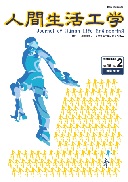All issues

Volume 3 (2002)
- Issue 4 Pages 46-
- Issue 2 Pages 36-
- Issue 1 Pages 37-
Volume 3, Issue 4
Displaying 1-2 of 2 articles from this issue
- |<
- <
- 1
- >
- >|
-
An example of improvement for the shrink film of the toothpaste.Yuusuke HAKAMATA, Haruo WATANABE, Akinori KOMATSUBARA2002 Volume 3 Issue 4 Pages 46-52
Published: 2002
Released on J-STAGE: May 21, 2021
MAGAZINE FREE ACCESSElderly people often complain difficulties about such simple operation like unsealing of the packages of daily products. In this study, unsealing behavior of the shrink film of a tube of toothpaste was analyzed to clarify the characteristic of the operation behavior, and the improvements of unsealing of the shrink film were discussed. Unsealing behavior was recorded with video tapes, and transition of action was analyzed. Based on the results, it turned out that subjects observed first the whole of the tube to compose the mental model of the tube, and also observed details before unsealing. It turned out that there is a problem that the sign of unsealing position was poor so that subjects couldn’t notice the exact position. An improvement was made where arrow signs were clearly printed at the unsealing position on the film, and it led remarkably reduced trouble for unsealing of the shrink film. We can conclude that the indication signs which can construct proper mental model at users when they observe the object, are very important.View full abstractDownload PDF (2790K) -
Ergonomic evaluation of the cushion material.Moto NiSHIOKA, Akira OKADA, Kuniko YAMASHITA, Syusuke KAWAMORI, Hiroyu ...2002 Volume 3 Issue 4 Pages 53-60
Published: 2002
Released on J-STAGE: May 21, 2021
MAGAZINE FREE ACCESSIn this study, we have investigated how seating posture is influenced by the characteristics of seat materials from data of the subjective preference, the free-fall test and body pressure distribution. Firstly, seat feelings in initial and steady states of seating are evaluated on subjective rating. Secondly, we have tried free-fall test that is the application of the evaluation method of automotive seat for reproducing seat condition. We have analyzed body pressure distribution on seating surface and studied the relationship between the characteristics of a seat-cushion and seating posture. As a result, tendencies are revealed that seat feeling depends on the subjective rating in initial state of seating and hard cushion is evaluated as “worse”. In addition, it is demonstrated that free-fall test data have consistency with the subjective rating in initial state of seating. Furthermore, it turns out effective that the body pressure distribution is analyzed not only with high-pressure distribution or pressure variation but also with a distribution map for each ischium and femoral region. Thus it is shown that the body pressure distribution depends on characteristics of cushion.View full abstractDownload PDF (2924K)
- |<
- <
- 1
- >
- >|